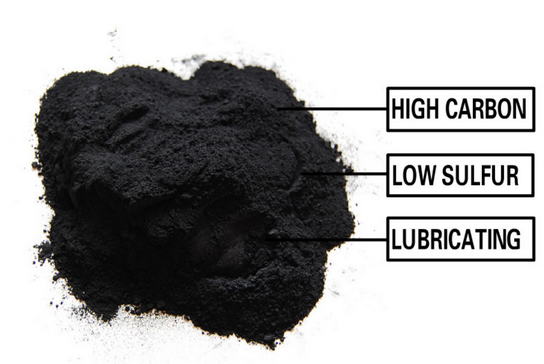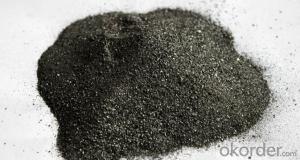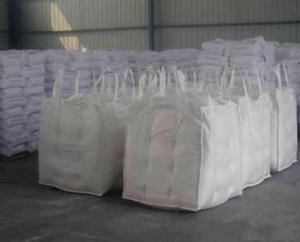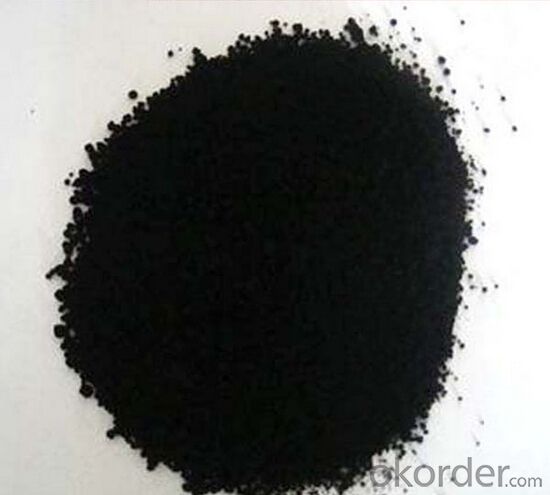Carbon Powder Carburant Carbon Additives Good enough
- Loading Port:
- Qingdao
- Payment Terms:
- TT OR LC
- Min Order Qty:
- 10 m.t.
- Supply Capability:
- 50000 m.t./month
OKorder Service Pledge
OKorder Financial Service
You Might Also Like
Specifications of Carbon Powder
- Carbon content: 94-99%
- Size: 50, 80, 100,200, 150, 300, 500 ,800mesh, etc
- Packing: 25kg or 1000kg
Carbon Powder Characteristics
Natural flake graphite has lubricity, high temperature resistant, conductive thermal conductivity, leakage, corrosion resistance, not good performance degradation
Carbon powder grain size
According to user requirements adjustment, main screening efforts for 50, 80, 100, 120, 150, 200, 325 mesh, etc
Carbon Powder Purposes
- As non-metallic mineral resources, has important defense strategic role
- Can be used for high and new technical projects, is of great economic and social benefits
- Is the metallurgical industry refractory material
- Is the chemical industry all kinds of corrosion of vessels, general equipment of carbon products
- Light industry is in pencil, ink and the main raw material of artificial diamond
- Is the electrical industry production carbon electrode and electrode carbon rods, battery materials

- Q: How do forests act as carbon sinks?
- Forests act as carbon sinks by absorbing carbon dioxide from the atmosphere through the process of photosynthesis. Trees and other plants take in carbon dioxide and convert it into oxygen, while storing the carbon in their trunks, branches, and roots. This stored carbon remains in the forest ecosystem, reducing the amount of greenhouse gases in the atmosphere and helping to mitigate climate change.
- Q: What is the chemical symbol for carbon?
- C is the designated chemical symbol for carbon.
- Q: How does carbon impact the ozone layer?
- Carbon does not directly impact the ozone layer. However, certain carbon compounds, such as chlorofluorocarbons (CFCs), can contribute to ozone depletion when released into the atmosphere.
- Q: Often see the so-called 30T, 46T, 60T carbon fiber, 60T carbon fiber, equivalent to T hundreds of carbon fibers, is T800, or T1000? I'm not very good at parameter conversion. Is there a parameter list? How do I correspond to the T300T700T800 performance parameter table?
- Two, 46T, 60T refers to high modulus carbon fibers. M series; T1000 refers to the high strength carbon fiber, belonging to the T series; M series and T series belong to different performance products.
- Q: How does carbon affect the migration patterns of birds?
- Carbon does not directly affect the migration patterns of birds. However, carbon emissions from human activities contribute to climate change, which can indirectly impact bird populations and their migratory behavior. Rising temperatures and altered weather patterns due to carbon emissions can disrupt food availability, breeding, and wintering grounds, potentially leading to changes in migration patterns as birds adapt to these new conditions.
- Q: What are the environmental impacts of carbon emissions from industries?
- The environmental impacts of carbon emissions from industries are significant and wide-ranging. Firstly, carbon emissions contribute to the greenhouse effect, which leads to global warming and climate change. The excessive release of carbon dioxide and other greenhouse gases into the atmosphere traps heat, causing the Earth's temperature to rise. This has resulted in the melting of polar ice caps, rising sea levels, and extreme weather events such as hurricanes and droughts. These changes disrupt ecosystems, lead to the loss of biodiversity, and threaten the survival of numerous species. Secondly, carbon emissions contribute to air pollution. Industries release not only carbon dioxide but also other harmful pollutants such as sulfur dioxide, nitrogen oxides, and particulate matter. These pollutants can have detrimental effects on human health, causing respiratory problems, cardiovascular diseases, and even premature death. In addition, they contribute to the formation of smog and acid rain, which further damage ecosystems and harm plant and animal life. Moreover, carbon emissions from industries have a negative impact on water systems. When carbon dioxide dissolves in water, it forms carbonic acid, leading to a decrease in pH levels and making the water more acidic. This acidification harms marine life, particularly organisms with shells or skeletons made of calcium carbonate, such as coral reefs, shellfish, and plankton. The disruption of marine ecosystems can have cascading effects on other species and disrupt the food chain. Lastly, carbon emissions contribute to deforestation and habitat destruction. Industries often rely on fossil fuels for energy, which leads to the clearing of forests to make way for mining or drilling operations. This destruction of natural habitats not only reduces biodiversity but also releases stored carbon from trees into the atmosphere, exacerbating the carbon emissions problem. To mitigate these environmental impacts, industries must prioritize the reduction of carbon emissions. This can be achieved through adopting cleaner and more sustainable energy sources, implementing energy-efficient technologies, and implementing stricter regulations and policies. Transitioning to renewable energy, improving industrial processes, and investing in carbon capture and storage technologies are essential steps towards mitigating the environmental impacts of carbon emissions from industries.
- Q: What are the effects of carbon emissions on human respiratory health?
- Carbon emissions have significant negative effects on human respiratory health. Exposure to high levels of carbon emissions, particularly from sources such as air pollution and vehicle exhaust, can lead to various respiratory issues. These emissions contain harmful pollutants like particulate matter, nitrogen dioxide, and sulfur dioxide, which can irritate the respiratory system and cause or exacerbate conditions such as asthma, bronchitis, and other respiratory diseases. Prolonged exposure to carbon emissions can also increase the risk of respiratory infections, reduce lung function, and contribute to the development of chronic respiratory illnesses. Additionally, carbon emissions contribute to climate change, which can worsen air quality and further impact respiratory health. Therefore, reducing carbon emissions is crucial for protecting and improving human respiratory health.
- Q: How does carbon impact the productivity of marine ecosystems?
- Marine ecosystems are greatly affected by carbon, impacting their productivity in various ways. One significant effect is seen through ocean acidification. When human activities release carbon dioxide into the atmosphere, a considerable portion is absorbed by the oceans. This excess carbon dioxide reacts with seawater, producing carbonic acid and causing a decrease in the ocean's pH. This rise in acidity has harmful consequences for numerous marine organisms, particularly those relying on calcium carbonate for their shells or skeletons, such as corals, shellfish, and certain plankton species. Ocean acidification hinders calcification, making it challenging for these organisms to develop and maintain their protective structures. This not only affects their survival but also has repercussions for the entire food chain. Many species depend on these calcium carbonate structures for food or shelter, so a decline in their productivity can have a cascading impact on the ecosystem. Moreover, heightened carbon dioxide levels in the ocean can also disrupt the metabolism and physiology of marine organisms. Some studies indicate that increased CO2 concentrations can impede the growth, development, and reproductive success of specific species. Consequently, overall productivity within the ecosystem decreases. Furthermore, marine ecosystems are also affected by climate change, which is fueled by the accumulation of carbon dioxide in the atmosphere. Rising temperatures disrupt the delicate balance of these ecosystems, altering the distribution and abundance of species, changing predator-prey dynamics, and causing shifts in the timing of crucial ecological events like spawning or migration. These changes have profound effects on the productivity of marine ecosystems, as different species struggle to adapt or compete under new conditions. In conclusion, carbon dioxide emissions have far-reaching consequences for marine ecosystems. Ocean acidification and climate change, both driven by excessive carbon dioxide, harm the productivity of marine ecosystems by impacting the growth, survival, and reproductive success of marine organisms. The effects of carbon on marine ecosystems underscore the urgent necessity to reduce greenhouse gas emissions and mitigate the impacts of climate change in order to protect these delicate and essential ecosystems.
- Q: The difference between double offset paper and carbon free printing paper
- In general, we use office A4, A3, B5 and other specifications of office paper are better offset paper, excellent offset paper to UPM and APP for the domestic leader.55G-140G grams in general, some mills also produce high grams, generally belongs to industrial paper!Carbon free copy is just typing paper and coating. Paint is divided into two kinds, one kind of colored, one kind of colorless.Generally for 37G, 45G, 52G and other grams.
- Q: The same manufacturer of different types of badminton rackets on the logo, but the two materials in the end what is the difference?
- Under the same force, high elasticity means that the elongation of the fiber is relatively large, and the high rigidity means that the elongation is relatively small.The racket hit the ball using high elastic fiber can withstand greater deformation, good toughness, a slowerThe racket hit the ball using high rigid fibers during deformation is small, hit the ball faster.
Send your message to us
Carbon Powder Carburant Carbon Additives Good enough
- Loading Port:
- Qingdao
- Payment Terms:
- TT OR LC
- Min Order Qty:
- 10 m.t.
- Supply Capability:
- 50000 m.t./month
OKorder Service Pledge
OKorder Financial Service
Similar products
Hot products
Hot Searches
Related keywords





















